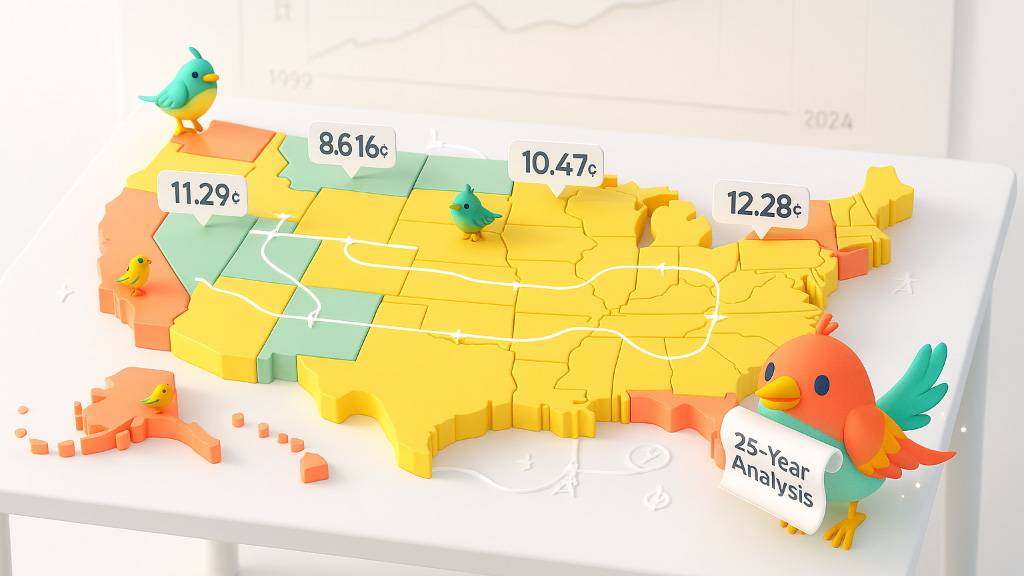In an era where energy costs touch every aspect of our lives, understanding electricity price trends has never been more critical. Our comprehensive analysis of electricity rates across all 50 US states from 1999 to 2025 reveals a story of dramatic increases, regional disparities, and evolving energy landscapes. Let's dive into what 25 years of data tells us about America's electricity costs.
The Rising Cost of Power in America (1999-2025)
Remember when electricity bills didn't make us wince quite so much? Back in 1999, Americans were paying an average of 7.5 cents per kilowatt-hour (kWh). Fast forward to 2025, and that number has nearly doubled, painting a picture of steadily climbing costs that have outpaced inflation.
The story isn't uniform across the country, though. California residents, who paid 14 cents per kWh in 1999, now face rates of 32.11 cents – a staggering 129% increase. Meanwhile, Idaho has maintained its position as one of the most affordable states for electricity, with rates rising from 5.1 to 8.67 cents over the same period.
But nothing compares to Hawaii's journey. The island state's unique energy challenges have pushed rates to an eye-watering 39.36 cents per kWh in 2025, making it the most expensive state for electricity by a significant margin.
Behind the Data: How We Analyzed 25 Years of US Electricity Rates
To understand these dramatic changes, we compiled comprehensive pricing data from every state, tracking the evolution of residential electricity rates from 1999 through 2025. This wasn't just about collecting numbers – it was about understanding the story behind each state's journey through changing energy landscapes, policy shifts, and technological advances.
We looked at price variations through multiple lenses: year-over-year changes, five-year intervals, and quarter-century transformations. This approach helped us identify not just the raw numbers, but the patterns and anomalies that tell the real story of America's evolving energy costs.
Power Price Divide: Understanding Regional Differences
Perhaps the most striking finding from our analysis is the deep regional divide in electricity costs. The Northeast consistently leads the pack with higher rates, while the Southeast and Midwest have traditionally enjoyed more moderate pricing – though this gap is slowly narrowing.
In the Northeast, states like Massachusetts, Connecticut, and Rhode Island have seen some of the most dramatic increases. Maine's journey is particularly noteworthy – from 10.1 cents/kWh in 1999 to 27.98 cents/kWh in 2025, representing a fundamental shift in the state's energy economics.
The West Coast tells its own unique story. While California grabs headlines with its high rates, neighboring Oregon and Washington have managed to maintain relatively moderate pricing despite facing similar environmental and regulatory challenges.
The Winners and Losers in State Electricity Rates
When it comes to electricity rates, your location matters – a lot. Let's look at the states that have managed to keep increases modest and those where residents have seen the most dramatic changes.
The Winners (Smallest Rate Increases):
- Idaho remains the standard-bearer for affordable electricity, with a 70% increase over 25 years
- Wyoming and North Dakota follow closely, with increases of 73% and 71% respectively
- These states have benefited from stable hydroelectric power and relatively lower infrastructure costs
The Losers (Largest Rate Increases):
- Hawaii leads with a 205% increase, driven by its isolation and dependence on imported fuel
- California's 129% increase reflects its aggressive renewable energy transition and infrastructure investments
- Connecticut's 146% jump showcases the broader challenges facing the Northeast
Price Drivers: What Makes Your Electric Bill Rise
Understanding why electricity prices rise means looking at a complex web of factors. Infrastructure investments, including grid modernization and renewable energy integration, play a major role. The retirement of aging power plants and their replacement with new facilities – whether renewable or conventional – adds to the cost burden.
Fuel costs remain a critical factor, with natural gas prices particularly influential in many regions. Environmental regulations and state-specific energy policies, especially renewable portfolio standards, have also pushed prices in different directions across various states.
Where Are Electricity Prices Heading?
Looking ahead, several trends seem likely to continue shaping electricity costs across America:
Regional disparities will persist, with the Northeast likely maintaining higher rates while the Southeast sees moderate increases. Western states face unique pressures from infrastructure needs and renewable energy transitions.
The pace of rate increases appears to be accelerating in many regions, with more states crossing into double-digit rates. Infrastructure modernization, grid reliability investments, and natural disaster preparedness will continue driving costs, especially in coastal states.
As we look to the future, one thing is clear: understanding these trends isn't just about watching numbers rise – it's about preparing for a changing energy landscape that will affect every American household.






